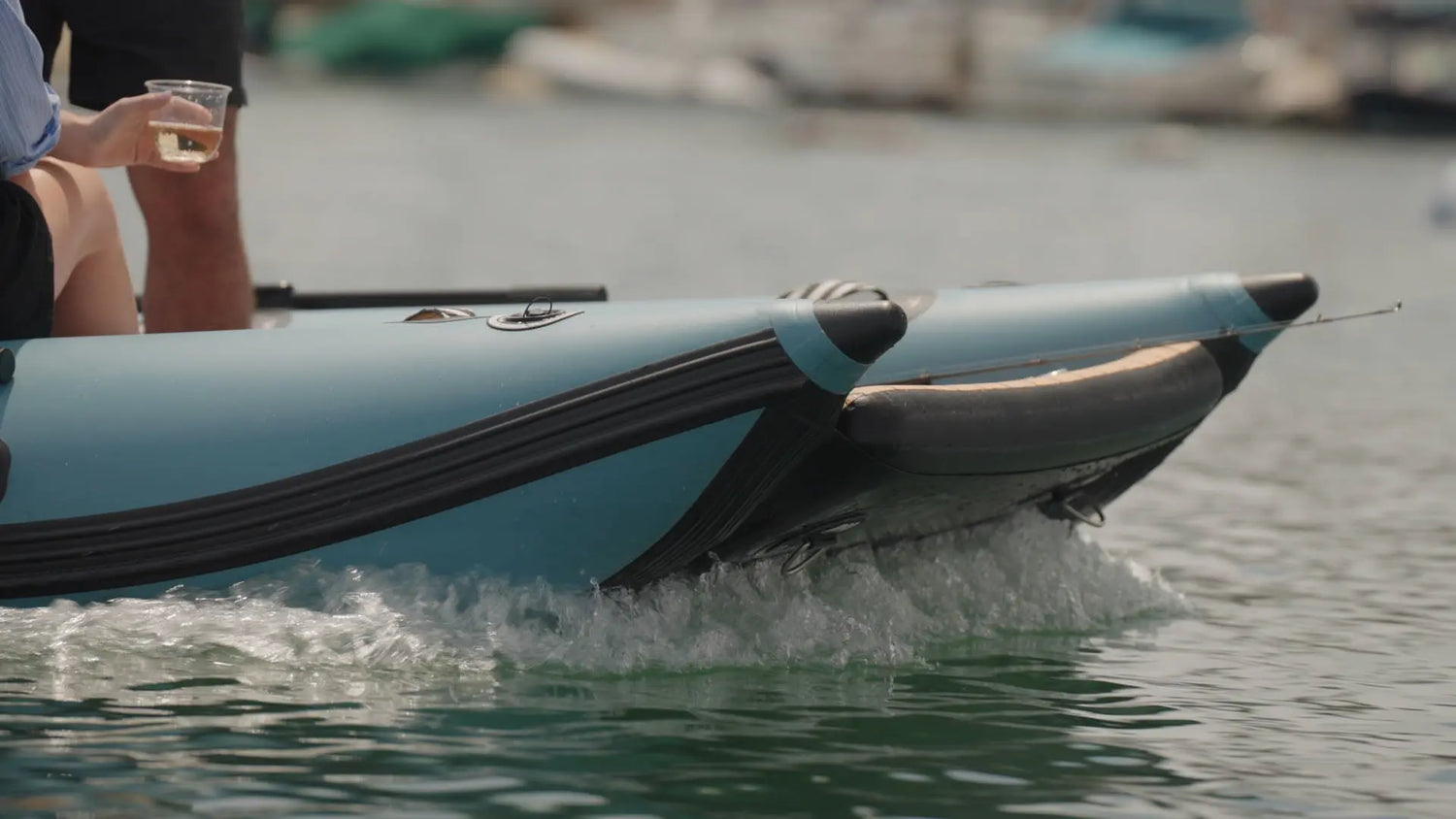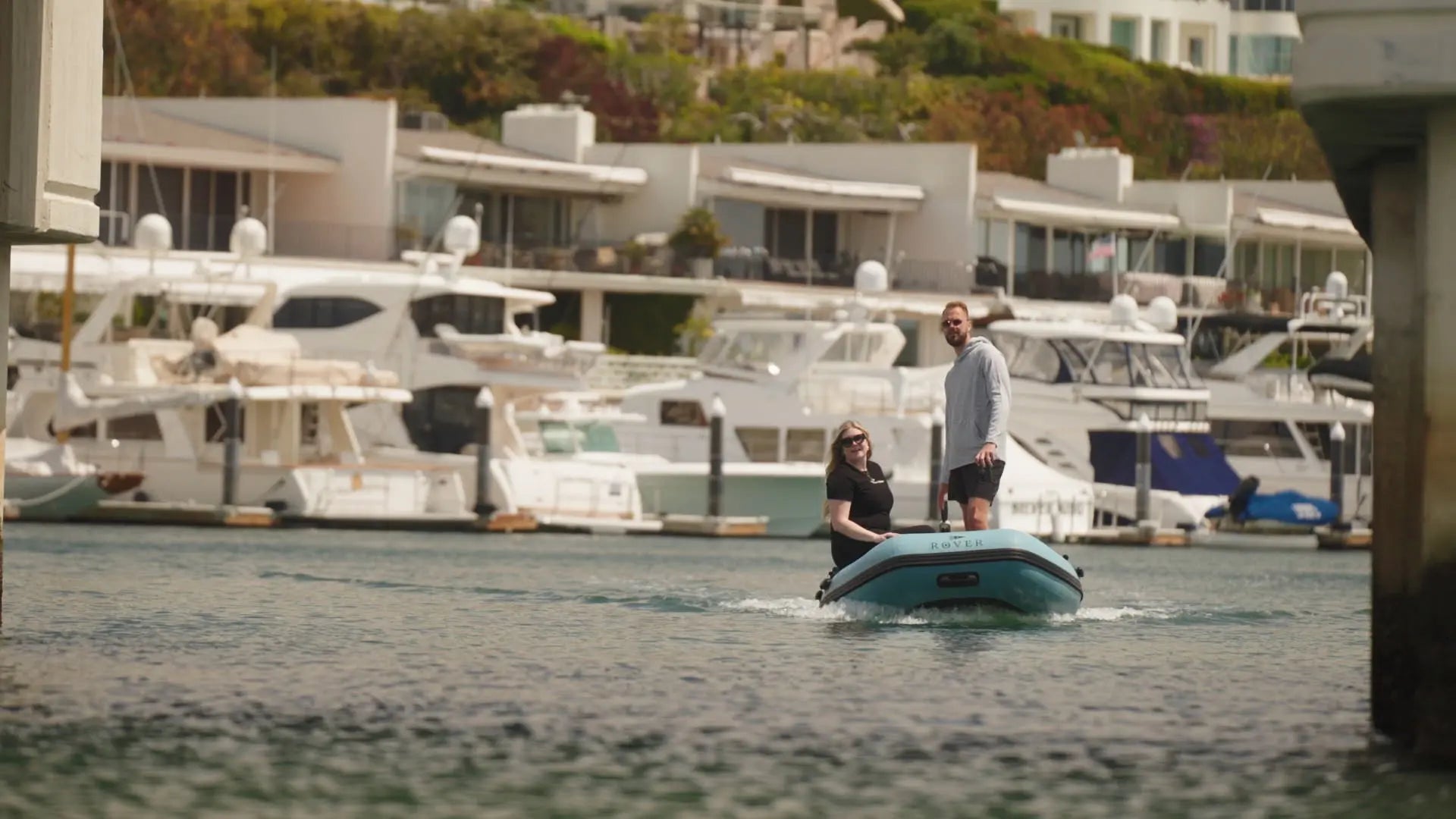Inflatable Dinghy vs. Rigid Hull: Which Is Best for Your Boating Needs?
Selecting the right tender can truly elevate your time on the water. Inflatable dinghies and rigid hull boats each bring distinct advantages—from effortless portability to unwavering durability—and understanding their core differences ensures you invest in the perfect partner for fishing, diving, yacht tending, or family cruising. This guide dives into construction, performance, cost, upkeep, safety, and propulsion options (including inflatable dinghy with outboard motor setups), finishing with tailored recommendations from Rover Marine.
What Are Inflatable Dinghies and Their Key Features?
Inflatable dinghies are lightweight craft built with air-filled tubes and a flexible floor, offering swift setup and compact storage. They rely on high-strength fabrics and inflatable chambers for buoyancy, making them ideal as yacht tenders, fishing platforms, or safari vessels where ease of transport is crucial.
What Types of Inflatable Dinghies Are Available?
Inflatable dinghies come in several configurations suited for different purposes: battle cat inflatable cat
- Roll-Up Tenders provide maximum compactness for stowing beneath bunks.
- Soft-Inflatable Boats (SIB) feature a flexible floor and are easy to beach.
- Rigid Inflatable Boats (RIB) combine a solid hull with inflatable tubes for enhanced performance.
These variations allow boaters to choose between ultimate portability, straightforward maintenance, or superior stability in choppy conditions.
How Do Hypalon and PVC Materials Affect Inflatable Dinghy Durability?
The fabric choice significantly impacts lifespan and resistance:
- Hypalon offers excellent resistance to chemicals, UV rays, and abrasion, lasting up to 15–20 years.
- PVC is a more budget-friendly option but may degrade more quickly under intense sunlight.
Opting for Hypalon boosts durability, while PVC offers a lower initial investment for less frequent use.
Summary
Material and design dictate whether an inflatable dinghy is best for weekend adventures or extended charters, leading us to their primary advantages.
What Are the Advantages of Inflatable Dinghies?
Inflatable dinghies offer four main benefits:
- Portability and Storage – They deflate into a compact package, simplifying trailering and onboard stowage.
- Initial Stability – Wide air tubes provide a stable, steady platform when at rest, perfect for boarding and fishing.
- Soft Impact Protection – The inflatable sides absorb impacts against docks and swim ladders without causing damage.
- Rapid Deployment – Quick inflation and minimal assembly mean you can be on the water in minutes.
These qualities make them a versatile choice, especially when space is a consideration.
What Are the Common Drawbacks of Inflatable Dinghies?
Three key limitations are worth noting:
- Puncture Vulnerability – While resilient, sharp objects can compromise air chambers, necessitating patch kits.
- Limited Performance – Air-tube drag can reduce top speed and fuel efficiency compared to hard-hull vessels.
- Routine Maintenance – Regular cleaning and inflation checks are needed to prevent mold and air leaks.
Understanding these trade-offs helps clarify your choice between soft and hard hull designs.
Which Rover Marine Inflatable Dinghy Models Should You Consider?
- Battle Boat – A Hypalon-fabric inflatable dinghy with a high-pressure inflatable floor, delivering rugged durability and seaworthiness. Discover the robust "Battle Boat" inflatable tender at Rover Marine.
- Battle Cat Inflatable Catamaran – A twin-tube design offering unmatched stability for fishing and leisure. Explore the versatile "Battle Cat Inflatable Catamaran" for multiple cabin configurations.
Both models can be fitted with electric outboard motors or gasoline outboards for quiet, efficient propulsion.
What Defines Rigid Hull Dinghies and Their Construction?
Rigid hull dinghies feature solid bottoms—crafted from fiberglass, aluminum, or wood—paired with fixed transoms. Their construction prioritizes straight-line speed and durability in rough conditions, though this comes with increased weight and a larger storage footprint.
What Are the Main Types of Rigid Hull Dinghies?
Boat manufacturers commonly utilize three materials:
- Fiberglass – Offers a smooth finish, allows for complex hull shapes, and provides corrosion-free hulls.
- Aluminum – Features lightweight framing, excellent impact resistance, and requires minimal maintenance.
- Wood – Presents classic aesthetics with traditional craftsmanship, needing protective coatings.
Each material influences the overall cost, weight, and repair procedures.
What Benefits Do Rigid Hull Dinghies Offer?
Rigid hulls excel in four key areas:
- Structural Durability – Solid hulls resist punctures and heavy use without the need for patching.
- High-Speed Performance – V-bottom or planing hulls cut through chop with reduced slapping.
- Directional Stability – Consistent tracking ensures a smoother ride in windy conditions and waves.
- Low-Maintenance Finish – Gelcoat or aluminum surfaces resist fading and mold growth.
This combination is ideal for serious anglers, divers, and those undertaking open-water excursions.
What Are the Limitations of Rigid Hull Dinghies?
Consider these potential drawbacks:
- Storage Challenges – A hard bottom requires dedicated rack space or davits.
- Heavier Weight – Trailering and lifting necessitate stronger trailers and lifting equipment.
- Higher Initial Cost – Material and manufacturing complexity increase purchase prices.
- Reduced Portability – On-board space and on-shore maneuvering demand more effort.
Balancing these factors against your performance needs is key to making the ideal choice.
How Do Inflatable and Rigid Hull Dinghies Compare on Key Factors?
| Tender Type | Portability | Durability | Performance |
|---|---|---|---|
| Inflatable Dinghy | Collapses to minimal volume | High with Hypalon, moderate with PVC | Up to 15 knots; soft ride at rest |
| Rigid Hull Dinghy | Requires rack or davit space | Excellent resistance to impact and wear | Up to 25 knots; smooth planing hull |
Which Dinghy Type Offers Better Stability and Seaworthiness?
Inflatable dinghies provide excellent initial stability due to their broad tubes, making boarding and anchoring feel calm and secure. Rigid hulls with V-bottoms offer superior directional stability in waves, minimizing slamming and bouncing at speed.
How Do Durability and Longevity Differ Between Dinghy Types?
Hypalon-reinforced inflatables, with proper care, often last 15–20 years, while rigid fiberglass or aluminum hulls can exceed 25 years with minimal structural upkeep. Solid hulls are entirely resistant to puncture.
What Are the Differences in Portability and Storage?
Inflatable dinghies deflate into a compact bag that fits easily on a garage shelf or yacht locker. Rigid hulls require permanent rack space or integrated davit systems, making them less adaptable for owners with multiple vessels.
How Do Performance and Handling Compare?
The rigid planing hull outperforms an inflatable tube at wide-open throttle and trims through chop with less spray. Inflatable boats excel in tight harbors with a low wake and agile turning at moderate speeds.
What Are the Maintenance Requirements and Costs for Each Type?
Inflatables require regular inflation checks, UV-protective rinses, and occasional patching, with repair kits typically costing $20–$50. Rigid hulls need annual hull cleaning, potential gelcoat touch-ups, and hull antifouling, with service costs averaging $200–$400 per year.
How Does Cost of Ownership Vary Between Inflatable and Rigid Dinghies?
Initial prices for a quality inflatable tender range from $2,000 to $5,000, while small rigid fiberglass dinghies start around $5,000 and increase with customization. Over the long term, a well-maintained inflatable can offer comparable value to a rigid hull over a decade.
What Safety Considerations Should You Know for Each Dinghy?
Inflatable dinghies feature multiple air chambers, providing redundancy if one compartment loses air. Rigid hulls offer solid buoyancy and typically store safety equipment below deck. Both require proper life jacket carriage, flotation aids, and secure attachment to the mother vessel.
How Do Outboard Motors Influence Dinghy Performance and Choice?
Selecting the right engine optimizes range, speed, and handling—especially for a lightweight tender.
Are Electric Outboard Motors Suitable for Both Inflatable and Rigid Dinghies?
Yes, electric outboards provide quiet, vibration-free power that is compatible with both soft and hard hulls. Their instant torque and minimal maintenance offset limited range for many day-use scenarios.
What Are the Benefits of Rover Marine’s Electric Outboards?
- The ePropulsion Spirit 1.0 Plus offers 1 kW output and a short shaft, ideal for inflatables with a focus on efficiency and weight savings.
- The Torqeedo Travel 1103 S delivers 1 HP equivalent thrust and integrated battery management for extended journey profiles.
These motors reduce noise pollution, eliminate the need for fuel storage, and integrate seamlessly with modern tenders.
How Do Outboard Motor Specifications Affect Dinghy Performance?
Key specifications include horsepower rating (0.8–15 HP), shaft length (15″ or 20″), and total weight (10–50 lbs). Higher horsepower increases top speed, while lighter engines help preserve the tender’s buoyancy and balance.
Which Dinghy Is Best for Your Specific Boating Needs?
Matching your tender type to your intended activity ensures safety and enjoyment on the water.
When Is an Inflatable Dinghy the Ideal Choice?
Choose an inflatable tender when:
- Space is Limited – Yacht owners require compact tenders that can be stowed in lockers.
- Easy Launch/Retrieve – Solo boaters prefer quick, manual deployment.
- Quiet Cruising – Anglers and wildlife photographers value low-noise operation.
- Occasional Use – Weekend excursions don’t warrant permanent rack storage.
When Does a Rigid Hull Dinghy Excel?
Opt for a hard-bottom tender when:
- High Performance – Waterskiing or offshore runs demand speed and protection from spray.
- Heavy Loads – Gear-laden fishing or dive charters require stable, load-carrying hulls.
- Commercial Applications – Frequent launches at docks necessitate a robust hull.
- Long-Term Investment – Owners prefer a durable platform with minimal need for repairs.
Where to Find the Best Inflatable and Rigid Dinghy Solutions from Rover Marine?
Rover Marine offers a comprehensive selection of tenders and propulsion systems to suit every boater.
How to Explore Rover Marine’s Inflatable Dinghy Collection?
Visit the Battle Boat and Battle Cat Inflatable Catamaran pages for detailed specifications, customer reviews, and available accessories: Our Battle Boat inflatable dinghy and Battle Cat inflatable catamaran.
How to Choose the Right Electric Outboard Motor for Your Dinghy?
Review power, shaft length, and battery compatibility for the ePropulsion Spirit 1.0 Plus or Torqeedo Travel 1103 S to ensure a perfect match for your tender’s hull characteristics.
How Can You Contact Rover Marine for Expert Dinghy Advice?
For personalized guidance and quotes, Contact Our Dinghy Experts to discuss your boating needs and arrange delivery or charter services.
Your ideal tender is a blend of hull design, material science, and propulsion compatibility tailored to your specific on-water demands. Whether you need a pack-and-go inflatable with a whisper-quiet electric outboard or a robust fiberglass hull for offshore performance, Rover Marine provides proven solutions. Explore product details, connect with our specialists, and embark on your next boating adventure with confidence.






